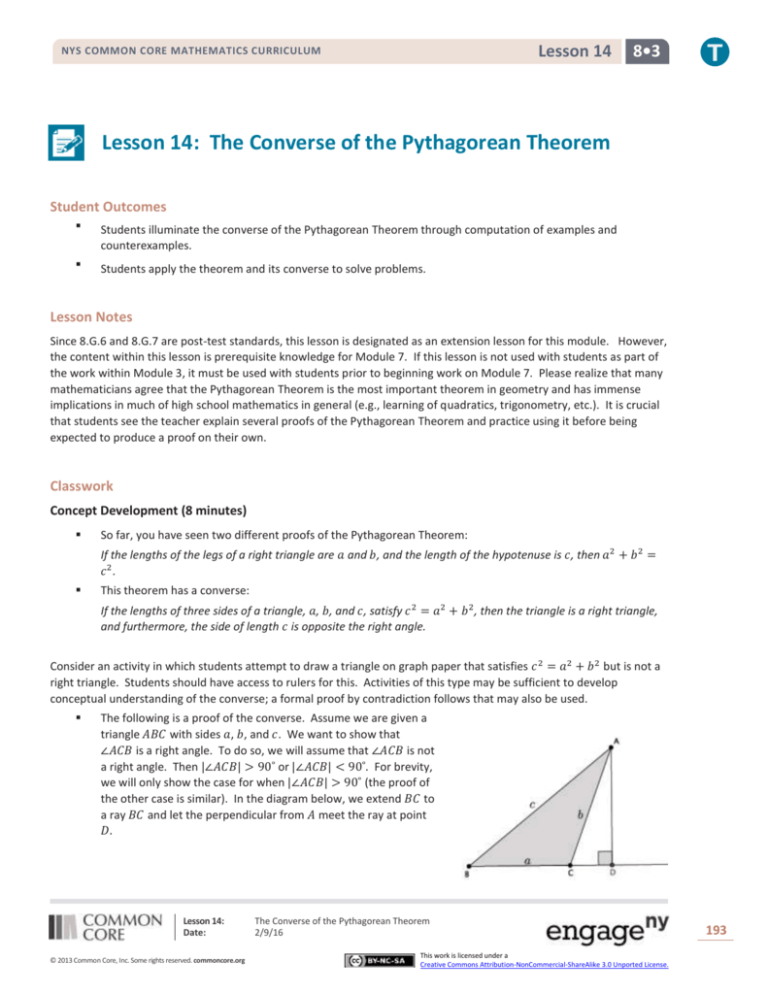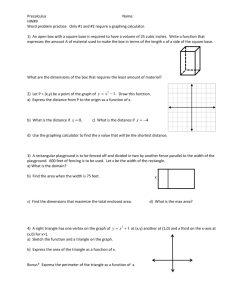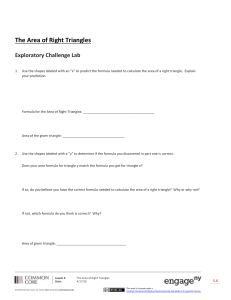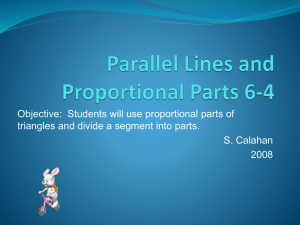
Lesson 14
NYS COMMON CORE MATHEMATICS CURRICULUM
8•3
Lesson 14: The Converse of the Pythagorean Theorem
Student Outcomes
Students illuminate the converse of the Pythagorean Theorem through computation of examples and
counterexamples.
Students apply the theorem and its converse to solve problems.
Lesson Notes
Since 8.G.6 and 8.G.7 are post-test standards, this lesson is designated as an extension lesson for this module. However,
the content within this lesson is prerequisite knowledge for Module 7. If this lesson is not used with students as part of
the work within Module 3, it must be used with students prior to beginning work on Module 7. Please realize that many
mathematicians agree that the Pythagorean Theorem is the most important theorem in geometry and has immense
implications in much of high school mathematics in general (e.g., learning of quadratics, trigonometry, etc.). It is crucial
that students see the teacher explain several proofs of the Pythagorean Theorem and practice using it before being
expected to produce a proof on their own.
Classwork
Concept Development (8 minutes)
So far, you have seen two different proofs of the Pythagorean Theorem:
If the lengths of the legs of a right triangle are 𝑎 and 𝑏, and the length of the hypotenuse is 𝑐, then 𝑎2 + 𝑏 2 =
𝑐2.
This theorem has a converse:
If the lengths of three sides of a triangle, 𝑎, 𝑏, and 𝑐, satisfy 𝑐 2 = 𝑎2 + 𝑏 2 , then the triangle is a right triangle,
and furthermore, the side of length 𝑐 is opposite the right angle.
Consider an activity in which students attempt to draw a triangle on graph paper that satisfies 𝑐 2 = 𝑎2 + 𝑏 2 but is not a
right triangle. Students should have access to rulers for this. Activities of this type may be sufficient to develop
conceptual understanding of the converse; a formal proof by contradiction follows that may also be used.
The following is a proof of the converse. Assume we are given a
triangle 𝐴𝐵𝐶 with sides 𝑎, 𝑏, and 𝑐. We want to show that
∠𝐴𝐶𝐵 is a right angle. To do so, we will assume that ∠𝐴𝐶𝐵 is not
a right angle. Then |∠𝐴𝐶𝐵| > 90˚ or |∠𝐴𝐶𝐵| < 90˚. For brevity,
we will only show the case for when |∠𝐴𝐶𝐵| > 90˚ (the proof of
the other case is similar). In the diagram below, we extend 𝐵𝐶 to
a ray 𝐵𝐶 and let the perpendicular from 𝐴 meet the ray at point
𝐷.
Lesson 14:
Date:
© 2013 Common Core, Inc. Some rights reserved. commoncore.org
The Converse of the Pythagorean Theorem
2/9/16
This work is licensed under a
Creative Commons Attribution-NonCommercial-ShareAlike 3.0 Unported License.
193
Lesson 14
NYS COMMON CORE MATHEMATICS CURRICULUM
Let 𝑚 = |𝐶𝐷| and 𝑛 = |𝐴𝐷|.
Then by the Pythagorean Theorem applied to △ 𝐴𝐶𝐷 and △ 𝐴𝐵𝐷 results in
8•3
𝑏 2 = 𝑚2 + 𝑛2 and 𝑐 2 = (𝑎 + 𝑚)2 + 𝑛2 .
2
2
Since we know what 𝑏 and 𝑐 are from the above equations, we can substitute those values into 𝑐 2 = 𝑎2 +
𝑏 2 to get
(𝑎 + 𝑚)2 + 𝑛2 = 𝑎2 + 𝑚2 + 𝑛2 .
Since (𝑎 + 𝑚)2 = (𝑎 + 𝑚)(𝑎 + 𝑚) = 𝑎2 + 𝑎𝑚 + 𝑎𝑚 + 𝑚2 = 𝑎2 + 2𝑎𝑚 + 𝑚2 , then we have
𝑎2 + 2𝑎𝑚 + 𝑚2 + 𝑛2 = 𝑎2 + 𝑚2 + 𝑛2 .
We can subtract the terms 𝑎2 , 𝑚2 , and 𝑛2 from both sides of the equal sign. Then we have
2𝑎𝑚 = 0.
But this cannot be true because 2𝑎𝑚 is a length; therefore, it cannot be equal to zero. Which means our
assumption that |∠𝐴𝐶𝐵| > 90˚ cannot be true. We can write a similar proof to show that |∠𝐴𝐶𝐵| < 90˚
cannot be true either. Therefore, |∠𝐴𝐶𝐵| = 90˚.
Example 1 (7 minutes)
To maintain the focus of the lesson, allow the use of calculators in order to check the validity of the right angle using the
Pythagorean Theorem.
The numbers in the diagram below indicate the units of length of each side of the triangle. Is the triangle
shown below a right triangle?
Scaffolding:
You may need to demonstrate
how to use the squared button
on a calculator.
In order to find out, we need to put these numbers into the Pythagorean Theorem. Recall that side 𝑐 is always
the longest side. Since 610 is the largest number, it is representing the 𝑐 in the Pythagorean Theorem. To
determine if this triangle is a right triangle, then we need to verify the computation:
?
2722 + 5462 = 6102
Lesson 14:
Date:
© 2013 Common Core, Inc. Some rights reserved. commoncore.org
The Converse of the Pythagorean Theorem
2/9/16
This work is licensed under a
Creative Commons Attribution-NonCommercial-ShareAlike 3.0 Unported License.
194
Lesson 14
NYS COMMON CORE MATHEMATICS CURRICULUM
8•3
Find the value of the left side of the equation: 2722 + 5462 = 372,100. Then, find the value of the right side
of the equation: 6102 = 372,100. Since the left side of the equation is equal to the right side of the equation,
then we have a true statement, i.e., 2722 + 5462 = 6102 . What does that mean about the triangle?
It means that the triangle with side lengths of 272, 546, and 610 is a right triangle.
Example 2 (5 minutes)
The numbers in the diagram below indicate the units of length of each side of the triangle. Is the triangle
shown below a right triangle?
What do we need to do to find out if this is a right triangle?
Which number is 𝑐? How do you know?
We need to see if it makes a true statement when we replace 𝑎, 𝑏, and 𝑐 with the numbers using the
Pythagorean Theorem.
The longest side is 12; therefore, 𝑐 = 12.
Use your calculator to see if it makes a true statement. (Give students a minute to calculate.) Is it a right
triangle? Explain.
No, it is not a right triangle. If it were a right triangle the equation 72 + 92 = 122 would be true. But
the left side of the equation is equal to 130, and the right side of the equation is equal to 144. Since
130 ≠ 144, then these lengths do not form a right triangle.
Exercises 1–7 (15 minutes)
Students complete Exercises 1–4 independently. Use of calculators is recommended.
Exercises
1.
The numbers in the diagram below indicate the units of length of each side of the triangle. Is the triangle shown
below a right triangle? Show your work, and answer in a complete sentence.
We need to check if 𝟗𝟐 + 𝟏𝟐𝟐 = 𝟏𝟓𝟐 is a true statement. The left side of
the equation is equal to 𝟐𝟐𝟓. The right side of the equation is equal to
𝟐𝟐𝟓. That means 𝟗𝟐 + 𝟏𝟐𝟐 = 𝟏𝟓𝟐 is true, and the triangle shown is a
right triangle.
Lesson 14:
Date:
© 2013 Common Core, Inc. Some rights reserved. commoncore.org
The Converse of the Pythagorean Theorem
2/9/16
This work is licensed under a
Creative Commons Attribution-NonCommercial-ShareAlike 3.0 Unported License.
195
Lesson 14
NYS COMMON CORE MATHEMATICS CURRICULUM
2.
8•3
The numbers in the diagram below indicate the units of length of each side of the triangle. Is the triangle shown
below a right triangle? Show your work, and answer in a complete sentence.
We need to check if 𝟑. 𝟓𝟐 + 𝟒. 𝟐𝟐 = 𝟒. 𝟓𝟐 is a true statement. The left side
of the equation is equal to 𝟐𝟗. 𝟖𝟗. The right side of the equation is equal to
𝟐𝟎. 𝟐𝟓. That means 𝟑. 𝟓𝟐 + 𝟒. 𝟐𝟐 = 𝟒. 𝟓𝟐 is not true, and the triangle
shown is not a right triangle.
3.
The numbers in the diagram below indicate the units of length of each side of the triangle. Is the triangle shown
below a right triangle? Show your work, and answer in a complete sentence.
We need to check if 𝟕𝟐𝟐 + 𝟏𝟓𝟒𝟐 = 𝟏𝟕𝟎𝟐 is a true statement. The left side
of the equation is equal to 𝟐𝟖, 𝟗𝟎𝟎. The right side of the equation is equal
to 𝟐𝟖, 𝟗𝟎𝟎. That means 𝟕𝟐𝟐 + 𝟏𝟓𝟒𝟐 = 𝟏𝟕𝟎𝟐 is true, and the triangle
shown is a right triangle.
4.
The numbers in the diagram below indicate the units of length of each side of the triangle. Is the triangle shown
below a right triangle? Show your work, and answer in a complete sentence.
We need to check if 𝟗𝟐 + 𝟒𝟎𝟐 = 𝟒𝟏𝟐 is a true statement. The left side of
the equation is equal to 𝟏, 𝟔𝟖𝟏. The right side of the equation is equal to
𝟏, 𝟔𝟖𝟏. That means 𝟗𝟐 + 𝟒𝟎𝟐 = 𝟒𝟏𝟐 is true, and the triangle shown is a
right triangle.
5.
The numbers in the diagram below indicate the units of length of each side of the triangle. Is the triangle shown
below a right triangle? Show your work, and answer in a complete sentence.
We need to check if 𝟏𝟎𝟐 + 𝟑𝟒𝟐 = 𝟑𝟔𝟐 is a true statement. The left side of
the equation is equal to 𝟏, 𝟐𝟓𝟔. The right side of the equation is equal to
𝟏, 𝟐𝟗𝟔. That means 𝟏𝟎𝟐 + 𝟑𝟒𝟐 = 𝟑𝟔𝟐 is not true, and the triangle shown
is not a right triangle.
6.
The numbers in the diagram below indicate the units of length of each side of the triangle. Is the triangle shown
below a right triangle? Show your work, and answer in a complete sentence.
We need to check if 𝟏𝟐 + 𝟓𝟐 = 𝟕𝟐 is a true statement. The left side of the
equation is equal to 𝟐𝟔. The right side of the equation is equal to 𝟒𝟗. That
means 𝟏𝟐 + 𝟓𝟐 = 𝟕𝟐 is not true, and the triangle shown is not a right
triangle.
Lesson 14:
Date:
© 2013 Common Core, Inc. Some rights reserved. commoncore.org
The Converse of the Pythagorean Theorem
2/9/16
This work is licensed under a
Creative Commons Attribution-NonCommercial-ShareAlike 3.0 Unported License.
196
Lesson 14
NYS COMMON CORE MATHEMATICS CURRICULUM
7.
8•3
The numbers in the diagram below indicate the units of length of each side of the triangle. Is the triangle shown
below a right triangle? Show your work, and answer in a complete sentence.
We need to check if 𝟐. 𝟓𝟐 + 𝟔𝟐 = 𝟔. 𝟓𝟐 is a true statement. The left
side of the equation is equal to 𝟒𝟐. 𝟐𝟓. The right side of the equation
is equal to 𝟒𝟐. 𝟐𝟓. That means 𝟐. 𝟓𝟐 + 𝟔𝟐 = 𝟔. 𝟓𝟐 is true, and the
triangle shown is a right triangle.
Closing (5 minutes)
Summarize, or ask students to summarize, the main points from the lesson:
We know the converse of the Pythagorean Theorem states that if side lengths of a triangle 𝑎, 𝑏, 𝑐, satisfy 𝑎2 +
𝑏 2 = 𝑐 2 , then the triangle is a right triangle.
We know that if the side lengths of a triangle 𝑎, 𝑏, 𝑐, do not satisfy 𝑎2 + 𝑏 2 = 𝑐 2 , then the triangle is not a
right triangle.
Lesson Summary
The converse of the Pythagorean Theorem states that if side lengths of a triangle 𝒂, 𝒃, 𝒄, satisfy 𝒂𝟐 + 𝒃𝟐 = 𝒄𝟐, then
the triangle is a right triangle.
If the side lengths of a triangle 𝒂, 𝒃, 𝒄, do not satisfy 𝒂𝟐 + 𝒃𝟐 = 𝒄𝟐, then the triangle is not a right triangle.
Exit Ticket (5 minutes)
Lesson 14:
Date:
© 2013 Common Core, Inc. Some rights reserved. commoncore.org
The Converse of the Pythagorean Theorem
2/9/16
This work is licensed under a
Creative Commons Attribution-NonCommercial-ShareAlike 3.0 Unported License.
197
Lesson 14
NYS COMMON CORE MATHEMATICS CURRICULUM
Name ___________________________________________________
8•3
Date____________________
Lesson 14: The Converse of the Pythagorean Theorem
Exit Ticket
1.
The numbers in the diagram below indicate the lengths of the sides of the triangle. Bernadette drew the following
triangle and claims it a right triangle. How can she be sure?
2.
Will the lengths 5, 9, and 14 form a right triangle? Explain.
Lesson 14:
Date:
© 2013 Common Core, Inc. Some rights reserved. commoncore.org
The Converse of the Pythagorean Theorem
2/9/16
This work is licensed under a
Creative Commons Attribution-NonCommercial-ShareAlike 3.0 Unported License.
198
Lesson 14
NYS COMMON CORE MATHEMATICS CURRICULUM
8•3
Exit Ticket Sample Solutions
1.
The numbers in the diagram below indicate the units of length of each side of the triangle. Bernadette drew the
following triangle and claims it a right triangle. How can she be sure?
Since 𝟑𝟕 is the longest side, if this triangle was a
right triangle 𝟑𝟕 would have to be the hypotenuse
(or 𝒄). Now she needs to check to see if 𝟏𝟐𝟐 +
𝟑𝟓𝟐 = 𝟑𝟕𝟐 is a true statement. The left side is
𝟏, 𝟑𝟔𝟗, and the right side is 𝟏, 𝟑𝟔𝟗. That
means 𝟏𝟐𝟐 + 𝟑𝟓𝟐 = 𝟑𝟕𝟐 is true, and this is a right
triangle.
2.
Will the lengths 𝟓, 𝟗, and 𝟏𝟒 form a right triangle? Explain.
No, lengths of 𝟓, 𝟗, and 𝟏𝟒 will not form a right triangle. If they did, then the equation 𝟓𝟐 + 𝟗𝟐 = 𝟏𝟒𝟐 would be a
true statement. However, the left side equals 𝟏𝟎𝟔, and the right side equals 𝟏𝟗𝟔. Therefore, these lengths do not
form a right triangle.
Problem Set Sample Solutions
Students practice using the converse of the Pythagorean Theorem and identifying common errors in computations.
1.
The numbers in the diagram below indicate the units of length of each side of the triangle. Is the triangle shown
below a right triangle? Show your work, and answer in a complete sentence.
We need to check if 𝟏𝟐𝟐 + 𝟏𝟔𝟐 = 𝟐𝟎𝟐 is a true statement. The left
side of the equation is equal to 𝟒𝟎𝟎. The right side of the equation is
equal to 𝟒𝟎𝟎. That means 𝟏𝟐𝟐 + 𝟏𝟔𝟐 = 𝟐𝟎𝟐 is true, and the triangle
shown is a right triangle.
2.
The numbers in the diagram below indicate the units of length of each side of the triangle. Is the triangle shown
below a right triangle? Show your work, and answer in a complete sentence.
We need to check if 𝟒𝟕𝟐 + 𝟐𝟒𝟐 = 𝟓𝟑𝟐 is a true statement. The left
side of the equation is equal to 𝟐, 𝟕𝟖𝟓. The right side of the equation
is equal to 𝟐, 𝟖𝟎𝟗. That means 𝟒𝟕𝟐 + 𝟐𝟒𝟐 = 𝟓𝟑𝟐 is not true, and the
triangle shown is not a right triangle.
Lesson 14:
Date:
© 2013 Common Core, Inc. Some rights reserved. commoncore.org
The Converse of the Pythagorean Theorem
2/9/16
This work is licensed under a
Creative Commons Attribution-NonCommercial-ShareAlike 3.0 Unported License.
199
Lesson 14
NYS COMMON CORE MATHEMATICS CURRICULUM
3.
8•3
The numbers in the diagram below indicate the units of length of each side of the triangle. Is the triangle shown
below a right triangle? Show your work, and answer in a complete sentence.
We need to check if 𝟓𝟏𝟐 + 𝟔𝟖𝟐 = 𝟖𝟓𝟐 is a true statement. The left
side of the equation is equal to 𝟕, 𝟐𝟐𝟓. The right side of the equation
is equal to 𝟕, 𝟐𝟐𝟓. That means 𝟓𝟏𝟐 + 𝟔𝟖𝟐 = 𝟖𝟓𝟐 is true, and the
triangle shown is a right triangle.
4.
The numbers in the diagram below indicate the units of length of each side of the triangle. Sam said that the
following triangle is a right triangle. Explain to Sam what he did wrong to reach this conclusion and what the correct
solution is.
Sam forgot to square each of the side lengths. In other words, he said
𝟖 + 𝟑𝟐 = 𝟒𝟎, which is a true statement. However, to show that a
triangle is a right triangle, you have to use the Pythagorean Theorem,
which is 𝒂𝟐 + 𝒃𝟐 = 𝒄𝟐. Using the Pythagorean Theorem, the left side
of the equation is equal to 𝟏, 𝟎𝟖𝟖, and the right side is equal to
𝟏, 𝟔𝟎𝟎. Since 𝟏, 𝟎𝟖𝟖 ≠ 𝟏, 𝟔𝟎𝟎, then the triangle is not a right
triangle.
5.
The numbers in the diagram below indicate the units of length of each side of the triangle. Is the triangle shown
below a right triangle? Show your work, and answer in a complete sentence.
We need to check if 𝟐𝟒𝟐 + 𝟕𝟐 = 𝟐𝟓𝟐 is a true statement. The left
side of the equation is equal to 𝟔𝟐𝟓. The right side of the equation is
equal to 𝟔𝟐𝟓. That means 𝟐𝟒𝟐 + 𝟕𝟐 = 𝟐𝟓𝟐 is true, and the triangle
shown is a right triangle.
6.
Jocelyn said that the triangle below is not a right triangle. Her work is shown below. Explain what she did wrong,
and show Jocelyn the correct solution.
We need to check if 𝟐𝟕𝟐 + 𝟒𝟓𝟐 = 𝟑𝟔𝟐 is a true statement. The left side of the equation is equal to 𝟐, 𝟕𝟓𝟒. The
right side of the equation is equal to 𝟏, 𝟐𝟗𝟔. That means 𝟐𝟕𝟐 + 𝟒𝟓𝟐 = 𝟑𝟔𝟐 is not true, and the triangle shown is
not a right triangle.
Jocelyn made the mistake of not putting the longest side of the triangle in place of 𝒄 in the Pythagorean Theorem,
𝒂𝟐 + 𝒃𝟐 = 𝒄𝟐. Specifically, she should have used 𝟒𝟓 for 𝒄, but instead she used 𝟑𝟔 for 𝒄. If she had done that part
correctly, she would have seen that, in fact, 𝟐𝟕𝟐 + 𝟑𝟔𝟐 = 𝟒𝟓𝟐 is a true statement because both sides of the equation
equal 𝟐, 𝟎𝟐𝟓. That means that the triangle is a right triangle.
Lesson 14:
Date:
© 2013 Common Core, Inc. Some rights reserved. commoncore.org
The Converse of the Pythagorean Theorem
2/9/16
This work is licensed under a
Creative Commons Attribution-NonCommercial-ShareAlike 3.0 Unported License.
200







